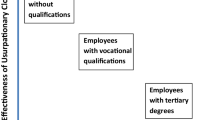Abstract
Employee benefits contribute to the stratification of the labor force into occupational markets. Employee benefits and earnings form “compensation packages” available in different combinations and at different levels to occupations located in different labor markets. In this study I have merged and aggregated data from the Current Population Survey Pension Suppolement in 1979 at the detailed occupation level with data from the Fourth Edition of the Dictionary of Occupational Titles to examine the relative importance of workforce characteristics, occupational content, and labor market context in the provision of selected employee benefits both separately and in combinations with earnings. The analyses reveal that fringe benefits are structurally-determined factors that represent a dimension of the reward structure of occupations different from earnings, but they combine with earnings to stratify the workplace into occupational markets.
Similar content being viewed by others
References
Anderberg, M. R. 1973 Cluster Analysis for Applications. New York: Academic Press.
Averitt, R. T. 1968 The Dual Economy: The Dynamics of American Industry Structure. New York: Norton.
1980 “Bringing the firms back in: Stratification, segmentation and the organization of work.” American Sociological Review 45:737–765.
1984 “The Organization of work in a segmented economy.” American Sociological Review 49:454–473.
Beck, E. M., P. M. Horan andC. M. Tolbert II 1978 “Stratification in a dual economy: A sectoral model for earnings determination.” American Sociological Review 43:704–720.
Blau, F. D. 1977 Equal Pay in the Office. Lexington, MA: D. C. Heath.
Bridges, W. P. 1982 “The sexual segregation of occupations: Theories of labor stratification in industry.” American Journal of Sociology 88:270–295.
Cain, P. S. D. J. Treiman 1981 “The DOT as a source of occupational data.” American Sociological Review 46:253–278.
Edwards, R. C. 1979 Contested Terrain. New York: Basic Books.
Form, W. H. andJ. A. Huber 1976 “Occupational power.” In R. Dubin (ed.), Handbook of Work, Organization and Society. Ch. 16: 751–806. Chicago, IL: Rand McNally.
Gordon, D. M., R. Edwards andM. Reich 1982 Segmented Work, Divided Workers: The Historical Transformation of Labor in the United States. Cambridge: Cambridge University Press.
Hauser, R. M. andD. L. Featherman 1977 The Process of Stratification: Trends and Analyses. New York: Academic Press.
1978 “Labor in the monopoly, competitive and state sectors of production.” Politics and Society 8:429–480.
1983 Workers' Earnings and Corporate Economic Structure. New York: Academic Press.
Kerr, C., J. T. Dunlop, F. H. Harbison andC. A. Myers 1960 Industrialism and Industrial Man. Cambridge, MA: Harvard University Press.
1979 “Why is there mandatory retirement?” Journal of Political Economy 87:1261–1284.
1983 Pensions as Severance Pay: Financial Aspects of the U.S. Pension System. Chicago, IL: University of Chicago Press.
Miller, A. R., D. J. Treiman, P. S. Cain andP. A. Roos 1980 Work, Jobs and Occupations: A Critical Review of the Dictionary of Occupational Titles. Washington, DC: National Academy Press.
Miller, D. C. andW. H. Form 1984 Industrial Sociology. New York: Harper & Row.
O'Rand, A. M. 1985 “Age, job attachment and pension acquisition.” Paper presented at the 80th Annual Meeting of the American Sociological Association, Washington, DC.
O'Rand, A. M. and V. M. MacLean 1985 “Occupations and compensations: Sexual segregation and occupational compensation differentials in a segmented economy.” Paper presented at the 80th Annual Meeting of the American Sociological Association, Washington, DC.
1986 “Labor markets, pension rule structure, and retirement benefits for long-term employees.” Social Forces 65:134–141.
Pampel, F. C. andJ. A. Weiss 1983 “Economic development, pension policies, and the labor force participation of aged males: A cross-national, longitudinal approach.” American Journal of Sociology 89:350–372.
Root, Lawrence L. 1985 “Employees benefits and social welfare: Complement and conflict.” The Annals of the American Academy of Political and Social Science 479:101–118.
SAS Institute, Inc. 1982 SAS User's Guide: Statistics. Cary, NC: SAS.
Slavick, F. 1966 Compulsory and Flexible Retirement in the American Economy. Ithaca, NY: Cornell University Press.
Spenner, K. S. 1980 “Occupational characteristics and classification systems: New uses of the dictionary of occupational titles in social research.” Sociological Methods and Research 9:239–264.
Titmuss, D. J. 1969 “The social division of labor.” In D. J. Titmuss (ed.), Essays on the Welfare State. Boston, MA: Beacon Press.
Treiman, D. J. 1977 Occupational Prestige in Comparative Perspective. New York: Academic Press.
U.S. Bureau of the Census 1982 Current Population Survey, May 1979: Survey of Pension Plan Coverage. Machine readable data file and documentation available from Inter-University Consortium for Political and Social Research, University of Michigan, Ann Arbor.
U.S. Department of Labor 1977 Dictionary of Occupational Titles, 4th ed. Machine readable data file available from Inter-University Consortium for Political and Social Research, University of Michigan, Ann Arbor.
Author information
Authors and Affiliations
Rights and permissions
About this article
Cite this article
O'Rand, A.M. The hidden payroll: Employee benefits and the structure of workplace inequality. Sociol Forum 1, 657–683 (1986). https://doi.org/10.1007/BF01107341
Issue Date:
DOI: https://doi.org/10.1007/BF01107341




